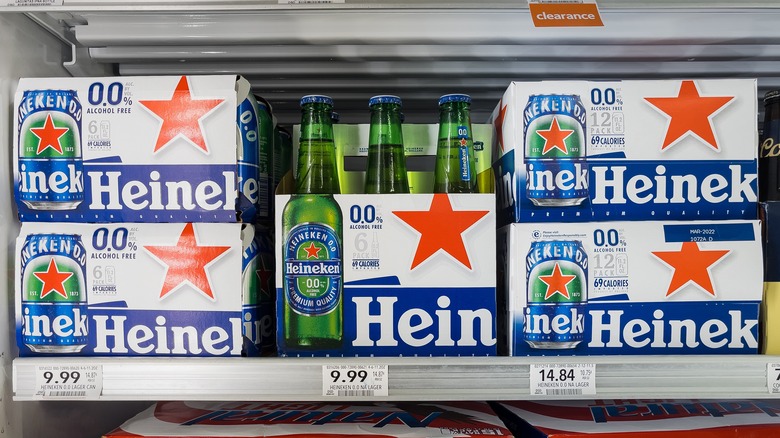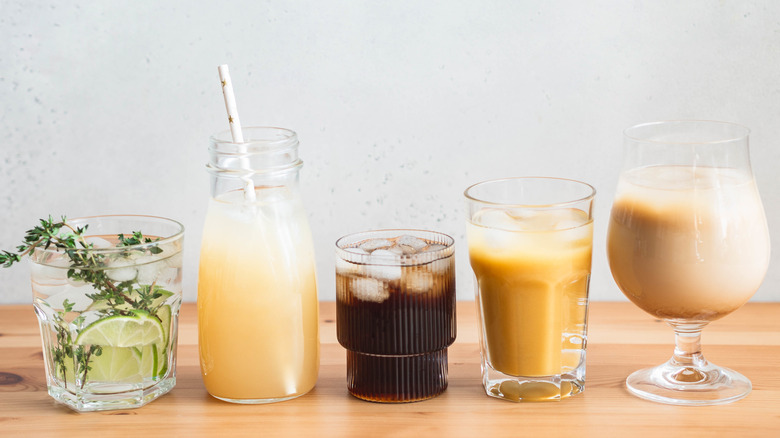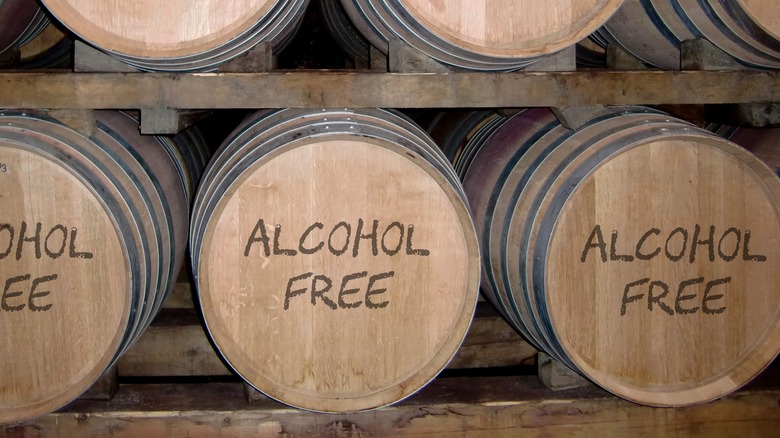'Non-Alcoholic' And 'Alcohol-Free' Labels Aren't Actually The Same Thing
Dry January has become more than just a month in America — people are drinking less alcohol than ever. While choosing sobriety is nothing new, the recent wave in the U.S. really took off in the wake of "pandemic drinking," according to The New York Times. People are limiting their booze intake through health trends like Whole30 and keto, and some are giving up alcohol altogether to live a sober lifestyle. Whether "sober curious," drinking mindfully, or cutting out the hard stuff entirely, the numbers are in and there's a national downtick in drinking (per Gallup).
So what is everyone drinking instead of alcohol? In the fairly recent past, the drink options for teetotalers were limited to soft drinks and juice — and if you were lucky, a combination of the two. These days, however, alcohol-free mocktails are a booming business. According to NielsenIQ, consumers spent $3.3 billion on low- and no-alcohol drinks in 2021, and the trend shows no sign of slowing down.
The New York Times has even declared that the booze-free cocktail has arrived, with a myriad of wines, beers, and even "dealcoholized" spirits hitting the market each month, and by extension bars and bottle shops that cater strictly to zero-proof drinkers. But before you go filling your glass, make sure you know the difference between "non-alcoholic" and "alcohol-free" drinks.
Non-alcoholic and low ABV
Perhaps because there is such a spectrum of interest in drinking alcohol, as described by Teen Vogue, there is also a corresponding spectrum of options that can have varying levels of alcohol ranging from very low to zero. For people who are simply cutting back on booze, a little bit of alcohol is not a problem and perhaps even welcome. However, it's important to know which products do have a bit of alcohol in them and which don't, as Food Network reports that, "the terms NA and AF are not necessarily interchangeable."
If you're going completely alcohol-free, steer clear of anything labeled "non-alcoholic" in the United States, such as NA beer. This is because in this country anything with less than 0.5% alcohol by volume (ABV) can be labeled as such, according to Healthline.
Wines and spirits are also in on the low-alcohol game, and there are several varieties coming out all the time, according to Food & Wine. Low-alcohol spirits are mostly simply lower-octane versions of vodka, gin, and whiskey, which are perfect for anyone who wants a night out with drinks, just fewer hangovers. The same is true for wines, so if you're heading out for cocktails and you are looking for zero alcohol, don't rely on something that says NA or low alcohol.
What alcohol free means
If you're looking for a drink that truly has zero alcohol, look for the term "alcohol-free." For non-drinkers, AF is the gold standard. U.S. law states that it can only be used on products that contain no alcohol whatsoever — 0.0% ABV, according to Legal Information Institute. For most products, this is often achieved by removing the alcohol mechanically (per The Food Network). Brewers can also make alcohol-free beer by preventing the alcohol from being developed, which is a cheaper process than taking away the alcohol as dealcoholization systems are expensive. Some spirits and wines are also made with no alcohol, such as Jukes wines, which is made with apple cider vinegar as a base (per Food & Wine).
If an AF product isn't clearly marked (which is rare), you can also always read the label for the ABV. Per the U.S. Alcohol and Tobacco Tax and Trade Bureau, the percentage of alcohol must be displayed on a product's label. Also, confusingly, the term "alcohol-free" can be used in the United Kingdom on products with less that have up to 0.5% ABV, according to Booze Free, so it's a good idea to keep up with the local laws if you're traveling abroad.
If you aren't sure if something has alcohol in it, the bottom line is just don't chance it. There are lots of drinks that don't require any alcohol alternatives. Any decent bartender can mix up something safe, and you can easily design one at home.


